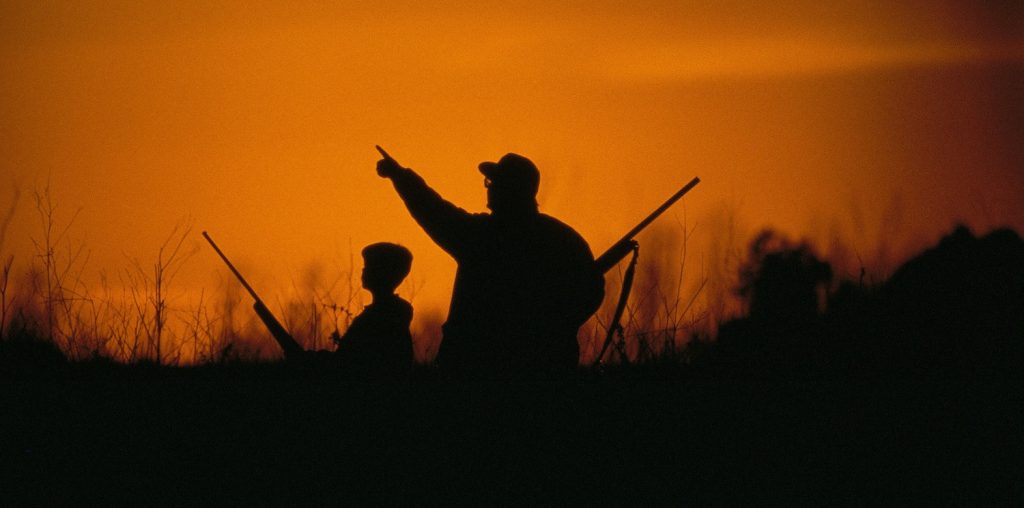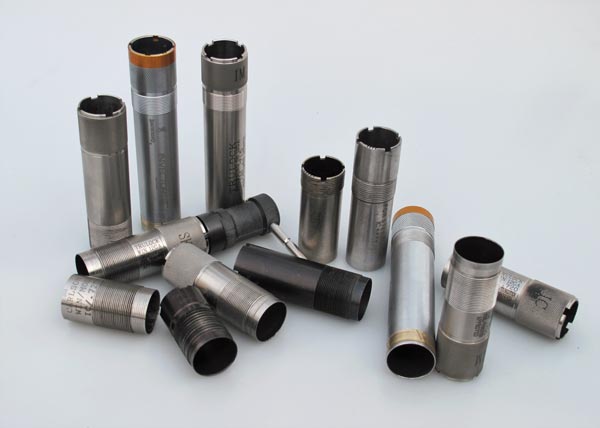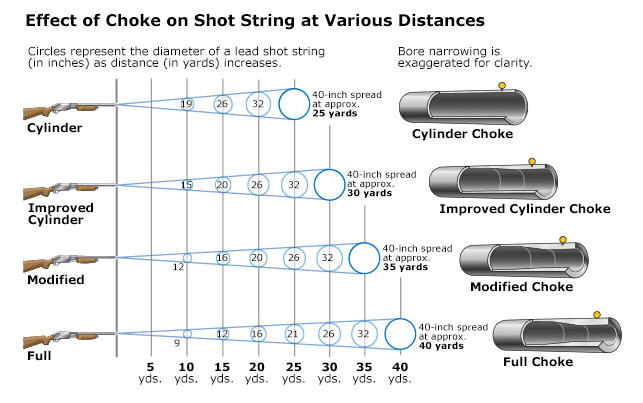
Pheasant and dove are two of the most popular game birds among hunters in the United States.
The techniques for hunting pheasant and dove require a good understanding of choke selection for each type of hunting.
Getting the most from your shotgun is a key to successful dove, turkey and pheasant hunting. Often choosing the right choke is the challenge.
A shotgun choke is a device the constricts or tapers the muzzle end of a shotgun. The tapering or constriction of the shotgun choke causes the shot to exit the barrel’s muzzle into a tighter pattern. A tighter pattern tends to cause the shot to fly further and for a denser shot concentration to hit the intended target.
Choosing the best shotgun choke for hunting pheasant and turkey involves several variables.
First, you must consider the type of hunting, the type and size of your shot, and your shotgun gauge.
All these factors work together to provide the most efficient shot patterns from your shotgun. Understanding how shotgun chokes work and how to select a shotgun choke can make you a better shotgun hunter.
Quick Answer:
Why? : The modified chokes typical ranges with lead or steel shot from 20 to 45 yards often offer bird hunters the greatest effective range spread. This wider range spread makes the modified choke the most popular choke choice among bird hunters in the US. Best Choke Manufacturer: Carlson’s Choke Tubes are the best in the industry. Not much to think here.
We have listed some widely used options below as well:
| Preview | Product | |
|---|---|---|

|
Carlsons Choke Tubes 12 Gauge Compatible for... | Check Price on Amazon |

|
Carlsons Choke Tubes 12 Gauge Compatible for... | Check Price on Amazon |
Last update on 2024-04-25
Why Chokes?

If you begin to explore shotgun chokes, the information soon becomes overwhelming.
This is especially true if you look at chokes for different gauges of shotguns such as 12 gauge, 20 gauge and 16 gauge.
Some manufacturers have different standards for the bore taper in their shotgun chokes to add to the confusion.
All in all, it can leave many people with glassy eyes and a headache.
The Basic Shotgun Choke
At its most basic, a shotgun choke is a device that fits into the muzzle of a shotgun and ads a very fine taper that works to constrict the size of the muzzle opening. As the shot exits the shotgun’s barrel, this taper compact the shot together, causing it to fly in a tighter formation.
The concept is to deliver more shot on target at a given distance.
A General Guide to Chokes and Shotshell Selection
Most shotshell manufacturers and shotgun manufacturers recommend shot size and choke selection in these ranges for these birds.
Remember that these recommendations are for 12 gauge shotguns.
Different gauges of shotguns will return different results and need choke and shotshell combinations.
| Game Bird | Shotshell Size | Shot Load | Choke Selection |
| Pheasants | 2 ¾ inches | 1 ¼ ounce of No. 6 Lead
1 1/8 ounces of No. 3 steel |
Modified or Improved Cylinder |
| Ducks | 3 inches | 1 ¼ ounces No. 2 Steel | Improved Cylinder or Modified |
| Geese | 3 inches | 1 ½ ounce No. 4 Tungsten | Improved Cylinder or Modified |
| Turkeys | 3 inches | 1 ¾ ounce No. 6 Tungsten | Full |
| Dove | 2 ¾ inches | 1 ounce No. 7 Steel
1 1/8 ounces No 7 ½ or 8 lead |
Improved Cylinder or Modified |
| Quail | 2 ¾ inch | 7/8 ounce No. 8 lead | Improved Cylinder or Modified |
It should quickly become apparent that an improved cylinder or modified choke will serve most hunters well for general hunting use.
How Much Taper Are We Talking About?
Not very much.
On a standard 12-gauge barrel, the inside diameter of the tube is .730 inches. Choke measurements are based on differences.
This is often where hunters become confused when talking or choosing hunting chokes.
To make this easier to understand, look at this chart.
| Choke Reference | Choke Measurement | Choke Difference |
| Cylinder Choke | .730 inches ID | 0 |
| Skeet Choke | .725 inches ID | .005 inches |
| Improved Cylinder | .721/.720 inches ID | .009/.010 inches |
| Light Modified or Skeet 2 | .718/.715 inches ID | .012/.015 inches |
| Modified Choke | .711/.710 Inches ID | .019/.020 inches |
| Improved Modified Choke | .705 inches ID | .025 inches |
| Full Choke | .695 inches ID | .035 inches |
The chart shows the size of the muzzle opening for each choke and the difference in the size of the opening in relation to the unchoked shotgun barrel.
To make better choices about which choke to choose for your hunts, there is some other information that you must understand about each of these shotgun chokes.
Types of Shotgun Chokes

Cylinder Choke
A cylinder choke is effectively an unmodified muzzle with no taper.
The effective range of most shotguns with a cylinder choke is about 25 yards.
Under most circumstances, after 25 yards, the shot pattern becomes so erratic that having a reasonable chance of a hit becomes negligible.
Skeet Choke
The skeet choke is overlooked in the US but is more popular in Europe among game bird hunters.
The skit choke fits between the cylinder choke and the improved cylinder choke designations. Hunters who shoot ruffed grouse or woodcock often opt for a skeet choke.
Hunters who hunt with lead shot find the skeet choke is especially effective between 5 and 20 yards.
Where steel shot is mandated, the effective range of a skeet choke extends from 10 to 30 yards.
Improved Cylinder (IC) Chokes
The improved cylinder choke has long been popular with upland game bird hunters.
In most cases, adding an improved cylinder choke to your 12 gauge shotgun will give you ranges with lead shot from 10 to 25 yards.
Steel shot used with an improved cylinder choke gives ranges from 15 to 30 yards.
As shown in the chart, there is some variation in the actual internal diameter of some IC chokes.
This is often due to the age of the choke and the manufacturer’s specifications.
Light Modified (LM) or Skeet II Chokes
You won’t find a light modified or skeet II choke with any set of interchangeable chokes.
This size choke hasn’t gained a lot of popularity in the US. However, with some diligence, you can find light modified chokes on the market.
Adding a light modified choke to your 12 gauge shotgun should give you effective ranges from 15 to 30 yards with lead shot.
Steel shot usually gives effective ranges between 20 and 35 yards.
Modified (MOD) Chokes
A modified choke is the most used shotgun choke in the US for most hunting applications.
A typical 12 gauge shotgun shooting lead shot can expect ranges from 20 to 35 yards. If you shoot steel shot, you can reach effective ranges from 20 to 35 yards.
If you are limited to only one choke for your shotgun, the modified choke is the best choice.
Almost any game bird in the US can be hunted effectively using a modified choke on your 12 gauge shotgun.
Improved Modified (IM) Choke
Many shotgun target shooters opt for an improved modified choke.
The slightly greater taper gives an effective range with lead shot from 25 to 40 yards. Using steel shot pushes the effective ranges between 30 and 50 yards.
Many hunters who routinely shot larger game birds such as pheasants and turkey are opting for the improved modified choke.
Full Choke
Most upland game bird hunters will rarely have use for a full choke on their shotguns.
The effective range of most 12 gauge shotguns fitted with a full choke and lead shot is between 30 and 45 yards. Many choke manufacturers warn against shooting steel shot through their full chokes.
The harder shot can damage the choke and often leads to inconsistent patterning.
Full choke has long been the choice of waterfowl hunters because of the longer ranges possible with a full choke barrel.
However, many states now limit the use of lead shot or ban them entirely when waterfowl hunting.
This means hunters face a conundrum about which choke to use with the steel shot.
So, Which Choke Should I Use for Pheasant, Turkeys and Dove?
Good question and one that depends a lot on your shooting style, what you are hunting and why kind of ammunition you use.
Each of these can factor differently into the choice of choke for your shotgun.
Since we are talking about pheasant and Dove hunting, we will focus on chokes for those birds.
Shooting style
Shotgun hunters employ a wide range of shooting styles. Some hunters are quick.
These quick hunters can bring their shotgun to point rapidly, which shortens the range to their targets.
Others are slower, preferring to let their target gain a bit of distance before pulling the trigger.
When hunting pheasants, you may be a walking hunter who prefers to walk habitat land looking to flush a beautiful pheasant cock.
For example, suppose you prefer to be stationary and use drivers to bring the birds to you. In that case, you may need to consider your choke selection differently.
The key is to judge the distance of most of your shots and fit your choke to that range.
Ammunition Choices
Are you shooting lead or steel shot?
The choice of shot materials can make a huge difference in which shotgun choke you choose.
Steel shot fly differently than lead shot. Lead and steel react differently to the shotgun choke and give different patterns at different ranges.
In general, steel shot flies further than lead shot and maintains a tighter pattern over that distance.
With its almost 3 times greater mass than steel, lead shot often delivers more knockdown power at comparable ranges than steel shot.
The Game You Are Hunting
What you are shooting is a big factor in both choke selection and ammunition selection.
The typical wing shooter in the US takes most of their shots between 20 and 30 yards.
For larger game birds such as pheasants, these ranges may be a bit longer.
Dove hunters are usually stationary and wait for their quarry to fly into range.
Understanding the range of the ammunition you shoot and the qualities of the choke you use is important. The reactions of the birds should be considered as well.
Each of these can affect the distance at which you expect to take your shots.
The modified chokes typical ranges with lead or steel shot from 20 to 45 yards often offer turkey hunters the greatest effective range spread.
This wider range spread makes the modified choke the most popular choke choice among bird hunters in the US.
This chart should come in handy to make it easier to judge which choke is best for your hunting style.
| Choke Size | Lead Shot | Steel Shot |
| Cylinder | 0 – 15 yards | 0 to 20 yards |
| Skeet | 5 to 20 yards | 10 to 30 yards |
| Improved Cylinder | 10 to 25 yards | 15 to 30 yards |
| Light Modified | 15 to 30 yards | 20 to 35 yards |
| Modified | 20 to 35 yards | 25 to 45 yards |
| Improved Modified | 25 to 40 yards | 30 to 50 yards |
| Full | 30 to 45 yards | Not Recommended |
Our Choices for the Best Shotgun Chokes for Pheasant and Dove Hunting
In general, shotgun manufacturers offer a wide range of chokes for their shotguns.
You can purchase a shotgun with a fixed choke barrel if you only hunt one kind of bird.
However, a shotgun with a variable choke or accepts either screw in or slide in choke tubes is very popular and offers you a wider range of options when hunting.
These manufacturers offer a wide range of choke tubes of many shotguns and in many styles.
- Carlson Shotgun Chokes –
- 30 YEARS WORTH OF PATTERNS: No other company like ours at Carlson's Choke Tubes with 30 plus years...
- HIGH-QUALITY MANUFACTURED: Our high quality Sporting Clays Compatible for Beretta Benelli Mobil is...
- HIGH PERFORMANCE: Carlson's Choke Tubes Sporting Clays Compatible for Beretta Benelli Mobil 12 Gauge...
Last update on 2024-04-25
Carlson chokes are the choice of many hunters and guides. Carlson offers choke options for almost every shotgun manufacturer in a wide variety of sizes. The quality of these chokes is unquestioned.
- Briley Manufacturing –
Briley manufacturing has a long history of building high-quality choke tubes in the United States. Briley also offers gunsmithing services to retrofit your shotgun barrel for a threaded or slide-in choke tube. Briley chokes are popular among competition trap and skeet shooters.
- Trulock Choke Tubes –
Trulock offers choke tubes and sets for almost every shotgun manufacturer. Many shooters value Trulock for their customer service and support. Trulock is an American-owned company serving American hunters.
Remember, no one choke tube is right for every hunting situation.
Purchasing a set of choke tubes is your best guarantee that you will have the choke and ammunition combination that works best whether you are hunting pheasants, dove, or turkeys.
Patterning Your Shotgun – An Essential Task for Pheasant and Dove
No matter what shotgun you choose, what choke you install, or the type of ammunition you shoot, it is essential that you pattern your shotgun.
Patterning your shotgun will tell you the maximum ranges you should expect an effective number of pellets to land within a specified area. Only then can you make good decisions about which choke to use with which ammunition to become more accurate.
Of course, patterning a shotgun isn’t complicated, but it can take some time.
Here are our recommendations for patterning a shotgun to understand your most effective shotshell and choke combinations at a given distance.
Step 1: Be Safe
Observe all safety precautions when preparing to pattern your shotgun and at the range. Always wear your eye and hearing protection and observe the range rules. If there is a range master, pay attention to his instructions and orders.
Step 2: Go to the Range Prepared
Make sure you have everything you need to properly pattern your shotgun with various choke and shotshell patterns. You will need the following
- Your shotgun or shotguns
- A supply of each type of shotshell you anticipate shooting
- Your shotgun chokes
- A cleaning kit and tools
- An ample supply of white butcher paper sheets. More than likely, you will use one sheet of paper for each shotshell and choke combination
- A stapler or tape to hold your paper to the target stands
- A measuring tape if your range doesn’t have a preset target stand distance
- A good marker or pen for making notes.
Don’t forget your own personal comfort. Dress for the season and bring some water.
Step 3: Setup Your Targets
Staple or tape a sheet of butcher paper to the target stand at the appropriate distance. You may want to shoot the same choke and shotshell combination at several different distances to judge who the pattern is affected by distance.
Some people mark a dot in the center of their target paper as an aiming point for consistency.
Step 4: Take Your Shot
Shoot a single shotshell at the target, aiming for the center of the butcher paper. Only put one shot per piece of butcher paper. Immediately make a note on the butcher paper to include at least this information.
- The shotgun you used.
- The choke you used.
- The shotshell you are patterning. Include the manufacturer’s name, length, load, and pellet size.
- The distance of the target from the firing line
- Many people add a sequence number to keep track of which shot was fired. Start with number 1 and work your way up as you pattern different combinations.
Try to make your shots as consistent as possible.
Analyzing your Patterns
Back home from the range, lay each sheet of paper on a flat surface and scribe a 30-inch circle around the aiming point on the target. Count the number of pellet hits inside the 30-inch ring Scribe a second circle using the same center point of 20 inches in diameter. You should now have two rings on the paper. Count the number of pellet holes inside the 20-inch circle.
In general, pheasants are usually taken between 20 and 40 yards. Look at the patterns and find the highest concentration of pellets in the 20-inch ring at 40 yards. This is probably your best pattern for pheasants
Hunting dove requires a slightly different setup. In the US, doves are typically shot between 18 and 25 yards. Pick a combination of ammunition and choke that puts the highest concentration of pellets in the 20-inch ring at 20 yards.
Choosing the Right Combination Can Mean More Success
Understanding the theory behind chokes is a factor in hunting success.
Choosing the right combination of choke, shotshell, and distance is critical. You can refer to the below video for a quick intro about shotgun chokes:
However, you shouldn’t lose sight of the real reason you are hunting.
The thrill and enjoyment of being outdoors are why most of us hunt.
Becoming too obsessed with the science and mechanics of hunting can cost you some of that enjoyment.
